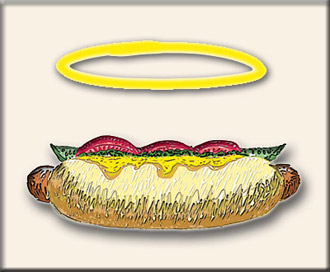A hot dog tastes better when served with a side of justice.
'We answer to a higher authority” is the tagline for Hebrew National’s famously kosher beef hot dogs. In other words a USDA stamp is one thing, but getting a kosher stamp of approval means that Hebrew National and other kosher food processors are reaching for a standard well above the concerns of mere civil servants. Acquiring that most estimable of labels by adhering to Jewish dietary and animal slaughter laws implies a quality and purity of the food product that has come to be meaningful to consumers well beyond America’s Jewish communities.
But in this era of industrial food production and global integration, is it enough to just worry over purity laws and procedures for animal slaughter? Is more required of the modern kosher consumer, or is kosher a standard writ in stone, unalterable even by the evolving ethical demands of the times?
That’s a battle being fought out today between folks who might be considered the strict constructionists of kosher laws and mavericks who argue that the laws should evolve with the changing times. What they’re fighting about is not an arcane adjustment to a slaughtering procedure, it’s the incorporation of a broad new layer of concern into the kosher standard: Hekhsher tzedek, or “justice certification.”
Conservative rabbis first proposed the new certification in 2006 after an exposé in the Jewish publication The Forward alleged some unsavory practices at Agriprocessors, one of the nation’s largest kosher food producers. The next year an Immigration and Customs Enforcement raid on an Agriprocessors plant in Postville, Iowa added to the controversy. The raid netted hundreds of undocumented workers, drove more into hiding and many into the hands of a local Catholic parish where they made the ancient appeal for sanctuary.
Emerging from this food fight is a set of new questions for the rabbinically-minded to puzzle over. What could the term kosher mean when applied to food that had been made by people enduring grueling working conditions, entrapped by poverty, made invisible by border policies, or simply working far below a living wage? What could it mean when applied to food derived from a slaughterhouse where children as young as 13 were alleged to be working? How should the kosher standard adapt to the contradictions and confusion offered up by the U.S. labor and immigration policy?
The fair trade commerce and sustainable agriculture movements have raised public awareness of many of the contemporary issues that swirl around global food production and commerce. The humane farming movement has likewise raised consciousness about the treatment of animals throughout our food production system. We’ve heard the moral and economic arguments in support of a broadly altered food delivery system, one that promotes authentic human development and good stewardship of the earth.
“Eating is a moral act,” the National Catholic Rural Life Conference has long argued. Perhaps what a new and improved kosher standard touches on, and what may have been lacking in some preceding arguments about the U.S. food system, is a reminder that eating food is also a profoundly spiritual act. Eating sustains our life force even as it connects us with the complete chain of creation, which includes the animals and earth that nourish us, and our brothers and sisters who have prepared the food for us.
Whether or not the proposed Jewish certification is ever adopted, it can only be helpful for the current kosher debate to escape from the rabbinate and be taken up by the rest of us. We are all called to be mindful of the ethical implications of food production and human nutrition. We are called to respond to the divine standards established by a higher authority. While we agonize over certain aspects of our food system, pretending that we’re free to neglect the human dignity of these members of our community that labor within it, wherever they were born, well, it hardly seems kosher.
This article was published in the February 2009 issue of U.S. Catholic (Vol. 74, No. 2, page 46).












Add comment